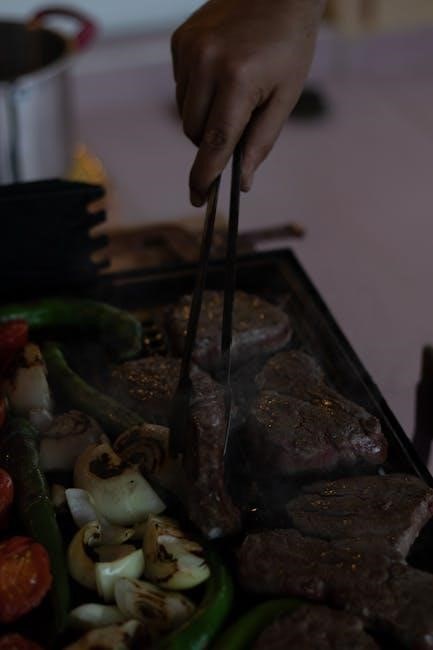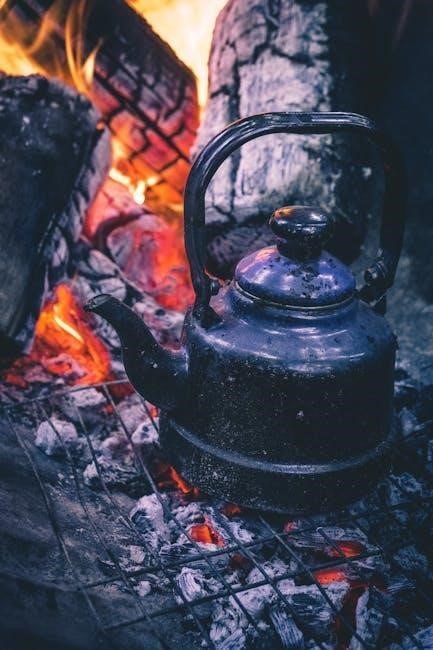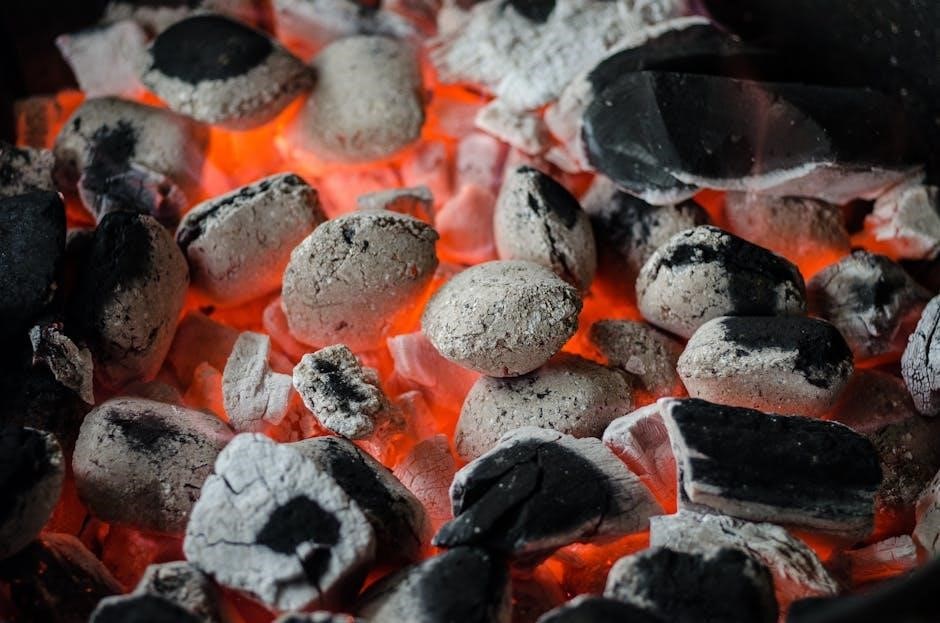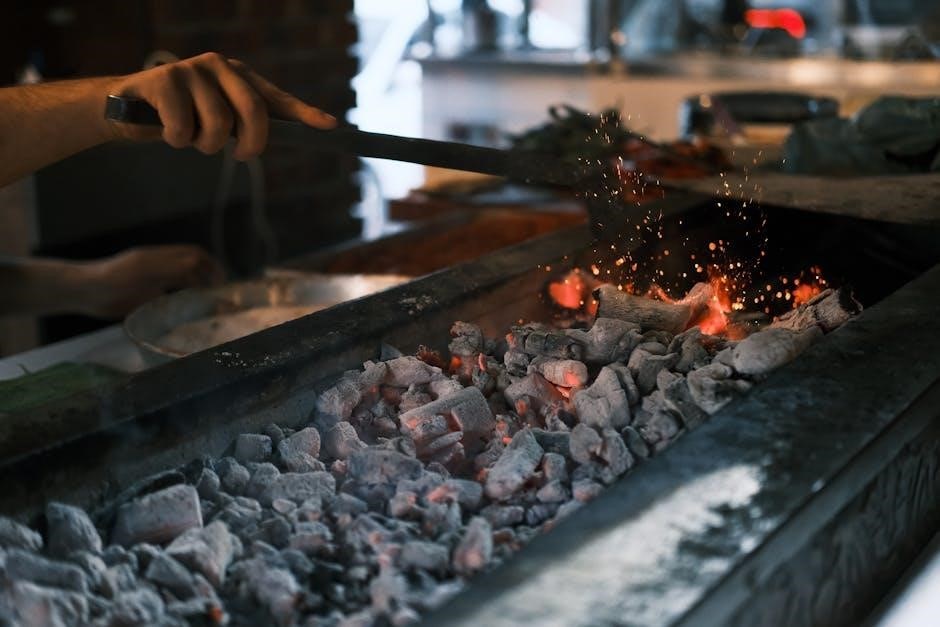george foreman grill temperature guide
The George Foreman Grill offers efficient, healthy cooking with precise temperature control, ideal for various foods. This guide helps users master optimal settings for perfect results every time.
Overview of the George Foreman Grill’s Popularity and Features
The George Foreman Grill has become a household name, celebrated for its innovative design and health-conscious approach to cooking. Its popularity soared in the 1990s, endorsed by the charismatic George Foreman, making it a staple in kitchens worldwide. Known for its lean, mean fat-reducing capabilities, the grill drains excess fat during cooking, offering a healthier alternative to traditional frying. Features include a non-stick surface, adjustable temperature settings, and versatility for grilling meats, vegetables, and even paninis. Compact models like the 4-Serving Classic Plate Grill are perfect for small kitchens, while larger options like the Indoor/Outdoor Electric Grill cater to families. Its energy efficiency and ease of use have solidified its place as a favorite for home cooks and health enthusiasts alike.
Importance of Temperature Control for Optimal Grilling
Temperature control is crucial for achieving perfect results when using the George Foreman Grill. Proper heat management ensures that food cooks evenly, preventing undercooking or burning. For meats, precise temperatures help retain juiciness and flavor, while for vegetables, it preserves texture and nutrients. Incorrect temperatures can lead to food sticking to the grill or uneven cooking. The grill’s adjustable settings allow users to tailor heat levels for different foods, from high searing for steaks to lower settings for delicate fish or vegetables. Maintaining the right temperature also enhances the grill’s non-stick performance, making cleanup easier. Mastering temperature control elevates your grilling game, ensuring every dish turns out delicious and healthy.

Understanding the George Foreman Grill’s Temperature Settings
The George Foreman Grill features adjustable temperature settings, typically ranging from 300°F to 400°F, designed for various cooking needs. Different models offer unique controls, ensuring precise heat management for consistent results.

Temperature Ranges for Different George Foreman Grill Models
Different George Foreman Grill models offer varying temperature ranges to suit diverse cooking needs. The Classic Plate Grill typically operates between 300°F and 400°F, ideal for everyday grilling. The Indoor/Outdoor model extends up to 450°F, perfect for searing meats. Compact models like the Small Fit Grill maintain consistent heat around 350°F, while advanced models, such as the SmartSpace series, feature digital temperature controls with precise adjustments. High-end models like the Evolve Grill offer a searing option, reaching up to 500°F for professional-level results. Each model’s temperature range is designed to optimize cooking performance, ensuring versatility for various foods and techniques.
How to Adjust and Monitor Temperature on Your George Foreman Grill
Adjusting and monitoring the temperature on your George Foreman Grill varies by model. For basic models, use the temperature dial to set heat levels, typically ranging from 300°F to 400°F. Advanced models feature digital controls with precise adjustments and searing options up to 500°F. Preheat by turning the dial or setting the digital display and wait for the indicator light to signal readiness. Some models have built-in sensors for consistent heat, ensuring even cooking without frequent checks. Regular cleaning is essential for accurate temperature control and even heating. Always refer to your specific model’s guide for detailed instructions and troubleshooting tips to ensure optimal performance and safety.

Optimal Temperatures for Different Types of Food
Discover the ideal temperature settings for grilling meats, seafood, vegetables, and more. Learn how to achieve perfect cooking results every time with your George Foreman Grill.
Recommended Temperatures for Grilling Meats (Steak, Chicken, Burgers)
For perfect meat grilling, the George Foreman Grill offers ideal temperature settings. Steak cooks best at medium-high heat (375-400°F) for searing, while chicken requires 350-375°F for even cooking. Burgers thrive at 375°F, ensuring juicy interiors. Adjusting these temperatures ensures optimal results, whether you prefer rare, medium, or well-done finishes. Always preheat the grill for consistent heat distribution and use a meat thermometer for accuracy. Proper temperature control prevents undercooking and enhances flavor, making your grilling experience effortless and delicious.
Best Temperature Settings for Vegetarian and Vegan Options
Vegetarian and vegan dishes thrive on the George Foreman Grill with precise temperature control. For vegetables like zucchini, bell peppers, and onions, a medium-low setting (300-325°F) ensures tender, caramelized results. Tofu and tempeh cook perfectly at 350°F, achieving a crispy exterior while maintaining a soft interior. Vegan burgers and black bean patties require a slightly higher temperature (350-375°F) for even cooking and a satisfying texture. Portobello mushrooms and eggplant benefit from 300-350°F for rich, smoky flavors. Always preheat the grill and lightly oil the surface to prevent sticking. These settings guarantee delicious, healthy meals that cater to plant-based diets, making the George Foreman Grill a versatile tool for all culinary preferences.
Temperature Guidelines for Seafood and Fish
Cooking seafood and fish on the George Foreman Grill requires careful temperature control to achieve perfectly cooked dishes. For delicate fish like salmon or tilapia, a medium-low setting (300-325°F) ensures flaky, moist results without overcooking. Shrimp and scallops benefit from a slightly higher temperature (325-350°F) for a crispy exterior while staying tender. Preheating the grill is essential for even cooking. Lightly oiling the grates prevents sticking. For heartier fish like mahi-mahi or swordfish, 350-375°F is ideal for a seared crust. Cooking times vary from 3-6 minutes, depending on thickness. Adjusting the temperature ensures seafood stays juicy and flavorful, making the George Foreman Grill a versatile tool for seafood enthusiasts.

Maintenance and Calibration of the George Foreman Grill
Regular cleaning ensures accurate temperature control and prolongs grill life. Calibrate your grill periodically to maintain consistent heat distribution and achieve optimal grilling results every time.
How to Clean and Maintain Your George Foreman Grill for Accurate Temperature Control
Cleaning your George Foreman Grill is essential for maintaining accurate temperature control and ensuring even cooking. Start by unplugging the grill to avoid any electrical hazards. Use a damp cloth to wipe down the exterior, removing any splatters or food residue. For the grates, allow them to cool before brushing off food particles with a soft-bristled brush or a paper towel. Avoid using abrasive cleaners or metal scourers, as they can damage the non-stick coating. For tougher stains, mix baking soda and water to create a paste, apply it to the affected areas, and let it sit for 30 minutes before rinsing with warm water. Regular maintenance prevents the buildup of grease and food residue, which can interfere with the grill’s temperature sensors and lead to uneven heating. Additionally, ensuring the drip tray is cleaned regularly helps maintain hygiene and prevents smoke during cooking. By following these steps, you can keep your George Foreman Grill in optimal condition, ensuring consistent temperature performance and extending its lifespan. Proper care also enhances the non-stick surface, reducing the risk of food sticking and making cleanup easier over time. Consistent cleaning habits will help maintain the grill’s efficiency and reliability, allowing you to achieve perfectly cooked meals every time. Regular deep cleans can also be done by soaking the removable parts in warm, soapy water for a few hours before scrubbing and rinsing thoroughly. Always refer to the user manual for specific cleaning recommendations tailored to your model, as some parts may require special care.
The Importance of Calibrating Your Grill for Consistent Results
Calibrating your George Foreman Grill ensures accurate temperature control, essential for consistent cooking results. Over time, temperature settings may drift due to wear or environmental factors, leading to undercooked or overcooked food. Calibration helps maintain precise heat levels, preventing food safety issues and ensuring even cooking. To calibrate, use a thermometer to verify the grill’s temperature against its settings, then adjust the dials as needed. Regular calibration is especially important after cleaning or moving the grill, as these actions can affect its performance. By maintaining accurate temperature control, you can achieve reliable results, whether searing steaks or cooking delicate fish. This simple step enhances your grilling experience and ensures your George Foreman Grill performs at its best for years to come.

Advanced Grilling Techniques Using Temperature Control
Mastering temperature control unlocks advanced grilling techniques like searing, low-and-slow cooking, and precision doneness for various foods, ensuring professional-quality results with minimal effort and maximum flavor retention.
Mastering the Searing Technique at High Temperatures
Mastering the searing technique at high temperatures is essential for achieving a perfect crust on your food. Preheat your George Foreman Grill to its highest setting (usually around 400°F) to ensure a hot surface. Pat dry your meat or vegetables to remove excess moisture, as this prevents steaming and promotes browning. Brush the grill with a small amount of oil to prevent sticking. Place your food evenly and avoid overcrowding the grill. Cook for 2-4 minutes on each side for meats, or until you see the desired sear marks. Use a thermometer to check internal temperatures for doneness. This method locks in juices and enhances flavor, creating a professional-quality finish.
Low-and-Slow Cooking on the George Foreman Grill
While the George Foreman Grill is known for high-heat searing, it can also be adapted for low-and-slow cooking with careful temperature control. For tender results, set your grill to a lower temperature (around 275-300°F) and use the lid if available. Place your food in a single layer to ensure even cooking. For meats like brisket or pulled pork, cook for 4-6 hours, flipping occasionally, until tender. Use a meat thermometer to monitor internal temperatures. Keep the grill clean to prevent flare-ups. This method is ideal for achieving fall-apart texture without an outdoor smoker. Experiment with marinades or rubs for added flavor. Patience is key for delicious, slow-cooked meals.

Troubleshooting Common Temperature-Related Issues
If your George Foreman Grill isn’t heating evenly or reaching the desired temperature, check for food residue and ensure proper power connection. Clean the grill and recalibrate if necessary for consistent results.
Why Your George Foreman Grill Might Not Be Heating Properly
Your George Foreman Grill may not heat properly due to a faulty power connection, worn-out heating elements, or excessive food residue blocking heat distribution. Ensure the grill is plugged into a working outlet and free from debris. If the non-stick coating is damaged, it might affect heat retention. Additionally, improper assembly or calibration can lead to uneven heating. Regular cleaning and maintenance are essential to prevent such issues. If the problem persists, check for loose connections or consider replacing worn-out parts. Proper care and calibration will ensure consistent heating for optimal grilling results. Always refer to the user manual for troubleshooting guidance.
How to Fix Uneven Heating on Your George Foreman Grill
Uneven heating on your George Foreman Grill can be resolved by ensuring proper preheating and cleaning. Start by unplugging the grill and letting it cool. Clean the plates thoroughly with a damp cloth to remove any food residue. Check for blockages in the drip tray, as they can disrupt airflow. Reassemble the grill correctly, ensuring all parts are securely locked. If issues persist, try resetting the temperature settings or calibrating the grill according to the manual. Avoid using abrasive cleaners, as they may damage the non-stick coating. Regular maintenance and even distribution of food can help achieve consistent heating for perfect grilling results every time.

Tips for Achieving the Best Results with Your George Foreman Grill
Preheat the grill fully, pat food dry before cooking, and avoid overcrowding. Clean regularly for consistent performance and to prevent food residue buildup over time.
Preheating Techniques for Consistent Temperature Distribution
Preheating your George Foreman Grill is essential for even cooking. Allow the grill to heat up for 3-5 minutes before adding food. Use the indicator light to ensure it’s ready. For models with adjustable settings, set the desired temperature and let it stabilize. A well-preheated grill ensures consistent temperature distribution, preventing hotspots and undercooked areas. This step is crucial for achieving ideal doneness, especially for meats and delicate foods. Regular preheating also helps maintain the grill’s efficiency and longevity, ensuring optimal performance over time. Always preheat with the lid closed to trap heat effectively.
How to Prevent Food from Sticking at Different Temperature Settings
To prevent food from sticking on the George Foreman Grill, ensure the grill is preheated properly before cooking. Lightly brush or spray the grilling surface with oil or cooking spray for added non-stick protection. Pat food dry with a paper towel to remove excess moisture, as dampness can cause sticking. For delicate foods like fish or vegetables, lower the temperature slightly to prevent them from adhering to the grill. Avoid flipping food too soon; let it sear for a minute to develop a natural release. Clean the grill regularly to maintain its non-stick coating and prevent residue buildup, which can contribute to sticking. Proper maintenance ensures consistent performance and prevents food from sticking at any temperature setting.
Mastering the George Foreman Grill’s temperature guide ensures perfectly cooked meals. Proper settings, maintenance, and techniques enhance flavor and texture. Experiment with recipes to unlock its full potential for healthy, delicious grilling.

The George Foreman Grill’s temperature guide emphasizes precise control for optimal results. Different foods require specific settings, from searing meats at high heat to gentle cooking for fish. Maintaining the grill through regular cleaning and calibration ensures accuracy. Techniques like preheating and preventing food sticking enhance performance. Experimenting with various temperature settings and cooking methods unlocks the grill’s full potential, offering healthy and flavorful meals. This guide provides a comprehensive approach to mastering the George Foreman Grill, ensuring delicious outcomes for every dish prepared.

Encouragement to Experiment and Explore More Grilling Possibilities
Exploring the full potential of your George Foreman Grill can lead to countless delicious discoveries. With precise temperature control, you can experiment with new recipes and techniques, from searing steaks to cooking vibrant vegetables. Try combining marinades, seasonings, and cooking times to create unique flavors. Don’t hesitate to venture beyond traditional grilling—your George Foreman Grill is versatile enough for paninis, seafood, and even vegan dishes. The key to mastery is creativity and practice. Embrace the versatility of your grill and uncover new favorites that impress family and friends. Keep experimenting, and let your George Foreman Grill become your go-to kitchen companion for healthy, flavorful meals.